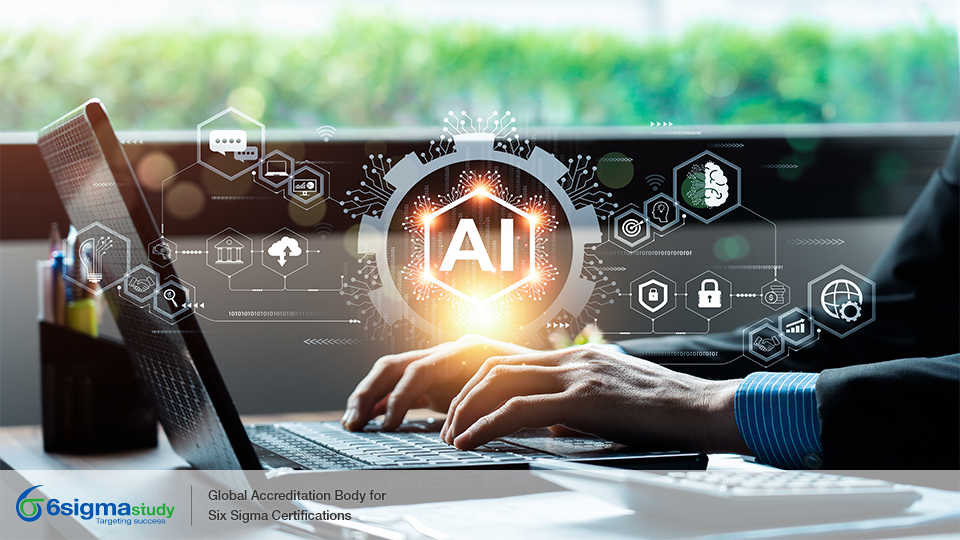Embracing AI in Process Improvement
Posted by 6sigmastudy® on February 05, 2024 | Lean & Six Sigma
Keywords: Six Sigma 6sigmastudy AI Artificial Intelligence Six Sigma Yellow Belt (SSYB™) Six Sigma Green Belt (SSGB™) Six Sigma Black Belt (SSBB™) Lean Six Sigma Green Belt (LSSGB™) Lean Six Sigma Black Belt (LSSBB™) Free Articles Free Six Sigma Articles TQM Six sigma define dmaic dmadv
Artificial Intelligence, especially generative AI, is transforming the realm of manufacturing and service operations. Traditionally led by human experts, the continuous improvement process is undergoing a significant shift. AI serves as a powerful catalyst, often outperforming conventional methods. This paradigm shift marks a game-changing era, where AI, with its capabilities, is enhancing and even surpassing traditional approaches in the relentless pursuit of operational excellence.
Lean and Six Sigma, known as "Lean Six Sigma," have long been central to process improvement, guided by expert "Black Belts." These methodologies, rooted in quality management, aim for efficiency. Yet, with technological progress, AI is reshaping this landscape. It's infiltrating every stage of the improvement cycle, challenging the belief that human expertise is exclusive. This shift signifies a departure from the traditional reliance on manual oversight, indicating that AI's role in enhancing and accelerating process improvement is on the rise.
The DMAIC routine, integral to Lean Six Sigma, showcases AI's transformative power in process improvement. Comprising Define, Measure, Analyse, Improve, and Check stages, DMAIC highlights AI's ability to revolutionize each step. From mapping processes with precision to accelerating analysis and customization, AI emerges as a key player in enhancing operational efficiency across the improvement spectrum.
Define: Harnessing AI for Process Mapping
In the Define stage, AI plays a crucial role by using digital records and process mining to understand and map complex processes in a company. Leading firms like Siemens, BMW, and Merck employ process mining technology to enhance overall processes, gaining deeper insights into their operations. This AI-driven approach improves the clarity and comprehension of intricate workflows, setting the stage for more effective decision-making and process optimization.
Measure: AI's Precise Process Assessment
In the Measure stage, AI is employed for precise assessment of process performance using IoT devices, barcodes, RFID devices, and cameras. Visual AI systems, driven by deep learning, excel in meticulous inspection during high-volume production, outperforming human capabilities. The combination of process mining software and AI ensures accurate measurement of execution times and identification of variations, laying the groundwork for well-informed decision-making.
Analyse: AI's Smart Pattern Recognition
In the Analyse stage, AI excels at handling big data, efficiently spotting patterns, and surpassing traditional Lean Six Sigma methods. Unlike the "Five Whys'' approach, AI quickly identifies root causes by avoiding false positives and examining the entire dataset. This makes problem-solving faster and more accurate, showcasing AI's effectiveness in uncovering insights and improving processes.
Improve: AI-Enhanced Optimization
In the Improve stage, AI makes a ground-breaking impact. Unlike conventional brainstorming, AI stands out in pinpointing optimal configurations based on performance data. It goes beyond the standardized processes of Lean Six Sigma by allowing customization, tailoring configurations to fit specific products and contexts. This signifies a shift in how processes are optimized, with AI leading the way in enhancing efficiency through tailored solutions.
Control: AI's Instant Monitoring
In the Control stage, AI excels in real-time process oversight. Utilizing advanced deep neural networks, it swiftly identifies anomalies, surpassing traditional methods. This applies across manufacturing and services, where AI's adeptness ensures operational smoothness by promptly detecting and addressing deviations, such as financial fraud. The technology's superior capabilities make it a crucial element in maintaining efficiency and security in various operational domains.
Challenges in Harmony: Humans and Technology
As AI becomes crucial for improvement, leaders face challenges. Traditional tools fade, challenging specialists used to scripted routines. Improvement experts need new skills, prompting a shift in training. This shift is essential for adapting to AI's role in enhancing operational efficiency.
Organizational change is unavoidable, requiring harmony between machines and human workers for smooth operation. While AI boosts efficiency, retaining workforce ownership is crucial. There's a risk of reduced engagement as AI handles tasks traditionally done by employees. This highlights the need to reassess strategies, ensuring active involvement and autonomy to overcome potential workforce disengagement.
AI's adeptness at complex tasks, along with generative AI systems allowing natural language interaction, opens a new era in enhancing operations. Leaders should welcome this shift, realign their workforce, build trust in AI, and ensure technology aids rather than hinders improvement. The on-going AI revolution in process enhancement holds significant potential for those prepared to embrace its transformative impact.
For more such interesting articles on Six Sigma and its concepts, please click here

